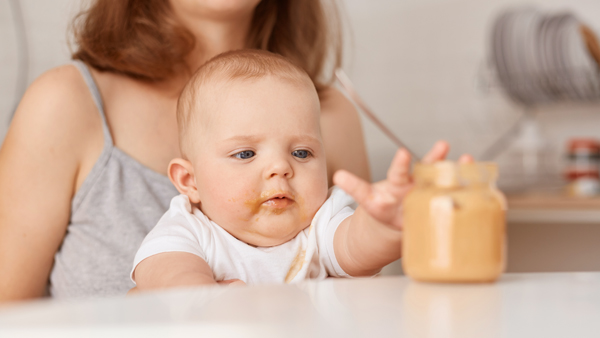What's a normal portion?
When you start introducing food to your baby, it’s common to wonder: How much should a baby eat at each meal? Many parents look at the amount in baby food jars and assume it’s a benchmark – but the best guide is actually your own baby!
Read time: 3 m
Verified by Sara Ask
Licensed dietitian
How much food is right for your baby?
The right portion size varies from child to child and depends on several factors:
– How active and alert your baby is
– How much breast milk or formula they have during the day
– Their daily mood and appetite
It’s completely normal for babies of the same age to have very different eating habits. Some 8-month-old babies eat almost like adults, while others still rely mainly on breast milk for nutrition. Both are perfectly fine – that’s why it’s so important not to compare your baby with others but to focus on your baby’s unique needs.
Signs your baby is getting enough food:
✔ Your baby seems content
✔ Development is progressing normally
✔ Weight and height follow expected growth curves
If there are any concerns about growth, your health visitor will raise them.
Should you encourage your baby to eat as much as possible?
It’s easy as a parent to try to get your baby to finish everything on their plate, but it’s important to respect their natural signals of fullness. Research shows that babies are naturally able to regulate their energy intake. They adjust their portion sizes based on how energy-dense the food is, and how many meals they have each day.
By letting your baby decide how much to eat, you support their ability to listen to their own body. Some days they’ll eat more, other days less – and that’s perfectly normal.
Creating a positive mealtime environment for your baby
To help your child tune into their hunger and fullness cues, try to reduce distractions at the table. Screens, toys, and other distractions can take focus away from the food and make it harder for your baby to recognise when they are full.
Tips for smoother mealtimes:
- Time the meal well – a baby who’s the right amount of hungry will eat better
- Offer something familiar plus something new– both comforting and stimulating
- Let your baby hold a spoon or pick up food themselves – it builds independence
- Eat together – babies learn by watching others
- Lower your expectations – every day is different, and that’s okay!
Sample daily menu for a 10–12 month old baby:
- Breakfast: Porridge + fruit purée
- Snack: Banana or yoghurt + fruit purée
- Lunch: Pasta/bulgur/potatoes + vegetables or root veg + fish/meat/egg/legumes. Optional: fruit or berries for dessert.
- Snack: Small sandwich with liver pâté or hummus
- Dinner: Similar setup to lunch
- Evening meal: Formula or porridge with fruit purée
Breast milk or formula can be offered with meals if your baby wants it. Always offer water as a drink at each meal.
Verified by Sara Ask
Licensed dietitian
More from Preggers
Hundreds of related articles, podcasts & more waiting for you in the Preggers app.
Download Preggers today.

